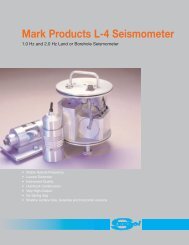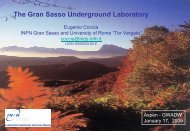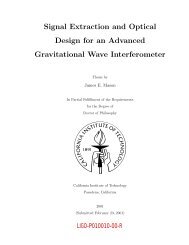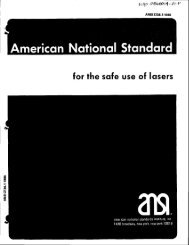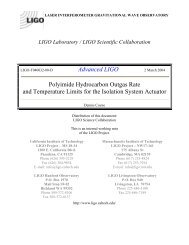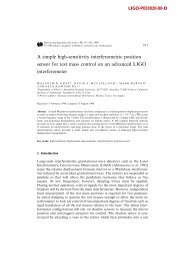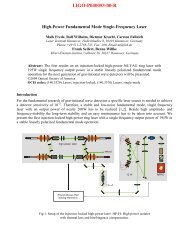LIGO-P030036-00-R - Ligo - Caltech
LIGO-P030036-00-R - Ligo - Caltech
LIGO-P030036-00-R - Ligo - Caltech
Create successful ePaper yourself
Turn your PDF publications into a flip-book with our unique Google optimized e-Paper software.
COMPARISON OF ADVANCED GRAVITATIONAL-WAVE ... PHYSICAL REVIEW D 65 082<strong>00</strong>1<br />
The appropriate was found from setting the derivative<br />
of the shot noise with respect to frequency at the resonance<br />
frequency of the sphere equal to zero. This insures the minimum<br />
of the shot noise, which is the dominant noise source at<br />
frequencies above 5<strong>00</strong> Hz, will be at the same frequency as<br />
the sphere’s most sensitive point. Since the frequency dependence<br />
of the shot noise is all in the function<br />
G 0 f 1/1/G 0,1 f 1/G 0,2 f ,<br />
this condition can be written<br />
41<br />
0G 0 f /<br />
r 3 †r 1 1r 2 2 sin2 f s r 2 „r 1 2 sin2 f s a sin2 f a s …‡/†2„1r 1 2 r 2 2 r 1 2 r 3<br />
2<br />
r 2 2 r 3 2 2r 1 r 2 1r 3 2 cos2 f a 2r 1 1r 2 2 r 3 cos2 f s 2r 1 2 r 2 r 3 cos2 f s a <br />
2r 2 r 3 cos2 f a s … 1/2 ‡.<br />
42<br />
Using this equation, the appropriate phase shifts for the signal<br />
recycling cavity were found, and are presented in Table<br />
III.<br />
The bandwidth of the sphere is determined by the impedance<br />
matching between the sphere and the SQUID amplifier.<br />
With a three stage transducer, this bandwidth is given by<br />
phase to 0.09. These signal-to-noise ratios are shown in the<br />
same figures with a dotted line.<br />
BW m 2 /m 1 ,<br />
43<br />
where BW is the fractional bandwidth of the sphere in the<br />
lossless limit 14. For the choices of masses in the transducer<br />
from Table I, this bandwidth becomes<br />
BW 10%.<br />
44<br />
In the interferometer, the bandwidth of the high frequency<br />
response is determined by the reflectivities of the input mirror<br />
and the signal recycling mirror, r 1 and r 3 respectively.<br />
The bandwidth of both the sphere and of the interferometer<br />
was calculated from<br />
BW 1/2 f 0 S tot f df 2 S 2 tot f df . 45<br />
To adjust the bandwidth of <strong>LIGO</strong> to better approximate the<br />
noise spectrum of a sphere, the values t 1 and t 3 were then<br />
chosen to get the minimum bandwidth possible. The values<br />
used for all frequencies were t 1 0.03 and t 3 0.<strong>00</strong>5. The<br />
bandwidth turns out to be higher than 10%, the sphere’s<br />
bandwidth, for all peak frequencies. Decreasing t 3 leads to<br />
losses dominating over the transmittance which limits the<br />
peak sensitivity.<br />
The resulting signal-to-noise ratios for the spheres and<br />
interferometer configurations are shown in Fig. 8 for the binary<br />
neutron star inspiral and coalescence, in Fig. 9 for the<br />
inspiral and coalescence phases separately, and in Fig. 10 for<br />
the rapidly rotating stellar core undergoing a dynamical instability.<br />
We also calculated signal-to-noise ratios for the<br />
sources interacting with <strong>LIGO</strong> in a broadband configuration<br />
optimized for binary neutron star inpiral. This involves<br />
changing the input transmittance, t 1 2 to 0.<strong>00</strong>5, the signal recycling<br />
mirror transmittance, t 3 2 to 0.05, and the accumulated<br />
FIG. 8. Energy signal-to-noise ratios for binary neutron star inspiral<br />
and coalescence. This source was simulated interacting with<br />
spherical resonant mass antennas shown with asterisks and interferometers<br />
operating with resonant sideband extraction shown with<br />
circles and a broadband interferometer shown with a dotted line.<br />
A The binary neutron stars were assumed at a distance of 15 Mpc.<br />
This distance is the closest estimated for a single event a year. Both<br />
detectors have high enough SNR’s to reach this distance. B The<br />
binary neutron stars were assumed at a distance of 2<strong>00</strong> Mpc. This<br />
distance is enough for multiple events for year, and advanced <strong>LIGO</strong><br />
with RSE does have a SNR high enough to reach this distance.<br />
082<strong>00</strong>1-11




